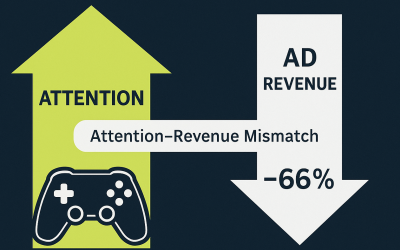Mastering Hybrid Monetization to Optimize LTV
Hybrid monetization, a strategy that combines various revenue streams such as in-app purchases, subscriptions, and ads, has emerged as a powerful approach to enhancing LTV. By diversifying income sources, app developers can create a more stable and scalable revenue model.
Increasing LTV by just 5% can boost profits by 25% to 95%? This staggering statistic underscores the importance of focusing on LTV to drive long-term revenue.
In this blog post I will try to address what it means, understanding and implementing hybrid monetization strategies so that you can maximize your app’s profitability.
[ez-toc]
Contents
Understanding Hybrid Monetization
What is Hybrid Monetization?
Hybrid monetization refers to the strategic combination of multiple revenue streams within a single app or game. Unlike relying solely on in-app purchases (IAPs) or advertisements, hybrid monetization blends various methods such as subscriptions, rewarded ads, offerwalls, and more. This approach not only diversifies income but also enhances user engagement by offering multiple ways to interact and spend within the app.
For instance, a mobile game might offer players the option to purchase in-game currency, watch rewarded video ads for extra lives, and subscribe to a premium membership for exclusive content. By integrating these diverse monetization methods, developers can cater to different user preferences and spending behaviors, thereby increasing the overall revenue potential.
Benefits of Hybrid Monetization
Continuing on “Mastering Hybrid Monetization to Optimize LTV“, the primary advantage of hybrid monetization is its ability to create a balanced and sustainable revenue model. Relying on a single source of income can be risky; if one stream underperforms, it can significantly impact overall revenue. However, with hybrid monetization, the risk is spread across multiple channels, making the app more resilient to market fluctuations.
Moreover, hybrid monetization can enhance user experience by providing choices. Users who are unwilling or unable to make direct purchases can still contribute to the app’s revenue through ads or subscriptions. This inclusivity can lead to higher user retention and satisfaction, as the app caters to a broader audience.
Strategies for Hybrid Monetization
Balanced Approach
A successful hybrid monetization strategy hinges on finding the right balance between different revenue streams. Overloading users with ads can lead to frustration and abandonment, while relying solely on in-app purchases might limit revenue to a smaller, paying user base. The key is to integrate monetization methods that complement each other and enhance the user experience.
Start by incorporating rewarded video ads strategically. These ads offer users incentives, such as extra lives or in-game currency, in exchange for watching short videos. This not only provides a non-intrusive way to earn ad revenue but also boosts user engagement by rewarding them for their time. Additionally, ensure that in-app purchases offer significant value, such as exclusive items or faster progression, making them attractive to users willing to spend.
2. Prioritize User Experience
User experience (UX) is paramount when implementing hybrid monetization strategies. A positive UX not only retains users but also encourages them to spend more over time. To optimize LTV, ensure that monetization methods do not disrupt the core functionality or enjoyment of your app. Ads should be non-intrusive and well-placed, while in-app purchases and subscriptions should offer genuine value without feeling coercive.
For example, rewarded ads should be seamlessly integrated at natural breakpoints, such as after completing a level in a game or finishing a task in a productivity app. Ensure that in-app purchase prompts are contextually relevant, providing users with timely offers that enhance their experience rather than interrupt it. Consistently gather user feedback to identify pain points and adjust your strategies accordingly to maintain a smooth and enjoyable user journey.
3. Leverage Analytics for Insights
Data-driven decision-making is essential for optimizing LTV. Utilize advanced analytics tools to track user behavior, preferences, and spending patterns. Key metrics to monitor include average revenue per daily active user (ARPDAU), conversion rates for in-app purchases, ad engagement rates, and user retention metrics.
By analyzing this data, you can identify which monetization strategies are most effective and which need improvement. For instance, if you notice a high drop-off rate after displaying certain ads, it may indicate that the ad format or placement needs adjustment. Similarly, if certain in-app purchase options have low conversion rates, consider revising their pricing or perceived value.
4. Personalize User Experiences
Continuing on “Mastering Hybrid Monetization to Optimize LTV“, Personalization can significantly enhance user engagement and increase LTV. Use data insights to segment your user base and tailor monetization strategies to different segments. Personalized experiences can range from customized in-app purchase offers to targeted ad placements based on user behavior.
 For example, offer discounts or special bundles to users who have shown interest in similar items or have a history of making purchases. For users who frequently engage with rewarded ads, provide them with exclusive opportunities to earn more rewards. Personalization not only increases the likelihood of conversions but also makes users feel valued, thereby boosting retention.
For example, offer discounts or special bundles to users who have shown interest in similar items or have a history of making purchases. For users who frequently engage with rewarded ads, provide them with exclusive opportunities to earn more rewards. Personalization not only increases the likelihood of conversions but also makes users feel valued, thereby boosting retention.
5. Implement Dynamic Pricing
Dynamic pricing involves adjusting the cost of in-app purchases, subscriptions, or ads based on various factors such as user behavior, market trends, and seasonal events. This flexibility allows you to maximize revenue without alienating users. For instance, offer special discounts during holidays or introduce limited-time offers to create a sense of urgency.
Additionally, consider implementing A/B testing for different pricing strategies to determine what resonates best with your audience. By continuously experimenting and adapting your pricing model, you can find the optimal balance that maximizes both user satisfaction and revenue.
6. Focus on Retention
User retention is a critical component of LTV. The longer users stay engaged with your app, the more opportunities you have to monetize them. To boost retention, provide regular updates with new features, content, and improvements. Gamify the user experience by introducing achievements, rewards, and loyalty programs that encourage continued engagement.
Implement push notifications and email campaigns to re-engage inactive users and keep current users informed about new content or offers. However, be mindful of not overwhelming users with too many notifications, as this can lead to frustration and churn.
7. Offer Exclusive Content and Features
Providing exclusive content or features through premium subscriptions or in-app purchases can significantly enhance LTV. Users are more likely to spend money if they perceive the value in what they are purchasing. For instance, offer premium members access to ad-free experiences, early access to new features, or exclusive in-game items.
Ensure that the exclusive content is regularly updated and of high quality to maintain its appeal. This not only incentivizes users to subscribe or make purchases but also fosters a sense of loyalty and commitment to your app.
8. Continuous Improvement and Adaptation
Continuing on “Mastering Hybrid Monetization to Optimize LTV”, the mobile app market is dynamic, and user preferences can change rapidly. To stay ahead, continuously monitor the performance of your monetization strategies and be ready to adapt. Regularly update your app based on user feedback and market trends to ensure that your monetization approach remains effective.
Stay informed about new monetization techniques, tools, and industry best practices. Participate in industry events, such as the Game Developers Conference (GDC), to network with other professionals and learn about the latest innovations in app monetization. By remaining proactive and adaptable, you can consistently optimize LTV and maintain a competitive edge in the market.
AppLixir Monetization
Optimizing lifetime value (LTV) through hybrid monetization is essential for sustaining and growing your app’s profitability. By balancing diverse revenue streams, personalizing user experiences, and continuously adapting your strategies, you can maximize LTV while maintaining user satisfaction. A critical component of this strategy is the effective use of rewarded video ads.
Rewarded video ads offer a non-intrusive way to generate revenue while enhancing user engagement. These ads provide users with valuable rewards in exchange for their time, creating a win-win situation that boosts retention and satisfaction. Integrating rewarded video ads seamlessly into your app can significantly contribute to your overall monetization efforts.
AppLixir specializes in providing high-quality rewarded video ad solutions that are easy to integrate and optimize for maximum revenue. Our platform ensures that your users enjoy a smooth, rewarding experience, while you benefit from increased ad revenue and improved LTV. By partnering with AppLixir, you can master hybrid monetization and take your app’s profitability to the next level.




